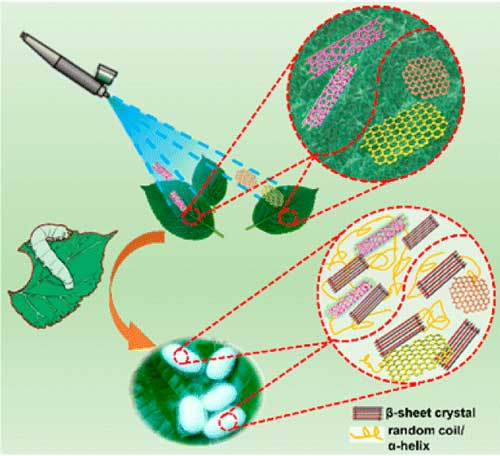| Posted: Oct 11, 2016 |
Silkworms eating graphene spin silk twice as strong
(Nanowerk News) Researchers at Tsinghua University in Beijing, China, have demonstrated that mechanically enhanced silk fibers could be naturally produced by feeding silkworms with diets containing single-walled carbon nanotubes (SWNTs) or graphene.
|
|
The as-spun silk fibers containing nanofillers showed evidently increased fracture strength and elongation-at-break, demonstrating the validity of SWNT or graphene incorporation into silkworm silk as reinforcement through an in situ functionalization approach.
|
|
The team has reported their findings in Nano Letters ("Feeding Single-Walled Carbon Nanotubes or Graphene to Silkworms for Reinforced Silk Fibers").
|
 |
| Researchers report mechanically enhanced silk directly collected by feeding Bombyx mori larval silkworms with single-walled carbon nanotubes (SWNTs) and graphene (© ACS).
|
|
The researchers conclude that "by analyzing the silk fibers and the excrement of silkworms, ... parts of the fed carbon nanomaterials were incorporated into the as-spun silk fibers, while others went into excrement.
|
|
FTIR spectroscopy of silks showed that SWNT and graphene-modified silks contained more α-helix and random coil structures and fewer β-sheets than controlled silk. This composition may contribute to increased breaking elongation and toughness modules, as the coil conformation consists of more movable chains than β-sheet.
|
|
Besides, the SWNTs and graphene may work as “slipknots,” leading to increased breaking elongation.
|
|
The scientists further investigated the influence of the carbon nanofillers on the structures and electrical conductivity of carbonized silk and found that the introduction of SWNTs or graphene promoted silk graphitization.
|
|
The team points out that this natural feeding strategy could be easily scaled up, paving a new path for the production of supertough silk fibers at a large scale.
|
|
"It is worth noting that there are still several interesting and important questions that cannot be answered by our current work, such as what is the safety limit of nanocarbons in the diets for the silkworms, how much of the nanocarbons taken by the silkworms are incorporated into the silk, and what is the detailed biological process," the researchers note. "Further studies regarding these interdisciplinary questions will be very interesting and valuable".
|

